U.S. Half Dollars
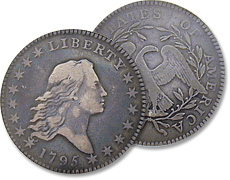
1794-95 Flowing Hair design
Flowing Hair Half Dollars, 1794‑1795
America's half dollar was among the country's earliest coinage, authorized by the mint Act of April 2, 1792. Half dollar history officially began in 1794, when the first Flowing Hair halves were struck. Issued for just two years, this design's obverse features the profile of Liberty with windswept hair. On the reverse, an eagle with wings raised stands within a wreath. The denomination appears on the edge, shown as FIFTY CENTS OR HALF A DOLLAR.
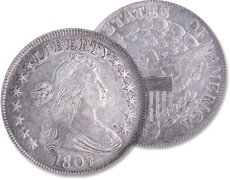
Draped Bust half
with Heraldic Eagle reverse
Draped Bust Half Dollars, 1796‑1807
Following the Flowing Hair half dollar, the history of half dollars continued with the Draped Bust coinage of 1796-1807. This design bears a new rendition of Liberty, with her loose hair tied in a ribbon. The series' original reverse, from 1796-1797, bore a smaller eagle within a wreath. No halves were minted from 1798-1800. When the denomination returned in 1801, the reverse featured a new heraldic eagle design with 13 stars.
Capped Bust Half Dollars, 1807‑1839
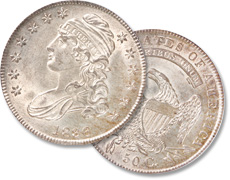
1807-39 Capped Bust half
Partway through 1807, the Draped Bust series was replaced by U.S. Mint Engraver John Reich's Capped Bust design. This series shows Liberty donning a cloth cap on her head. The reverse once again displays a smaller eagle, with a shield. Until 1836, the edge featured the denomination, once again inscribed as FIFTY CENTS OR HALF A DOLLAR. Partway through 1836, the coin's edge was changed to a simpler reeded style. This style remained until the end of the Capped Bust series in 1839.
See our Capped Bust half dollar inventory
Liberty Seated Half Dollars, 1839‑1891
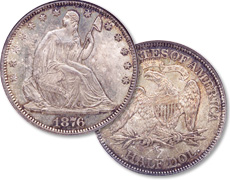
Liberty Seated half dollar
Half dollar history continued in 1839 with the debut of the Liberty Seated series. This handsome design features Liberty seated on a rock, her left hand holding a liberty cap on a pole, and her right hand resting on a shield inscribed LIBERTY. The reverse design depicts an eagle clutching an olive branch and arrows. Amid the religious fervor of the Civil War era, the motto IN GOD WE TRUST was added to the reverse in 1866, and continued through the end of the series in 1891. (Read more: The First Carson City Half Dollar Reverse Die)
See our Liberty Seated half dollar inventory
Barber Half Dollars, 1892‑1915
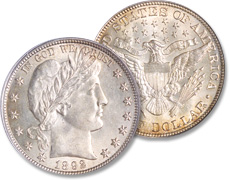
Barber half of 1892‑1915
Early half dollar history concludes with the 1892-1915 Barber coinage. During the last year of the Liberty Seated half dollar, the Treasury Department began a search for new coin designs. As a result, in 1892 Charles Barber's Liberty Head design debuted on the half dollar – as well as the dime and quarter. Better known as the Barber half dollar, the obverse features Liberty's profile, wearing a cap and laurel wreath on her head. A Heraldic Eagle graces the reverse. Thirteen stars appear on both obverse and reverse.
See our Barber half dollar inventory

